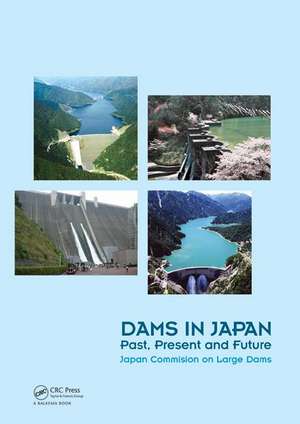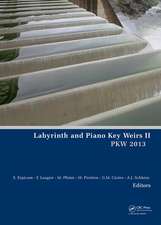Dams in Japan: Past, Present and Future
Editat de Japan Commission on Large Dams - JCOLDen Limba Engleză Hardback – 15 apr 2009
Preț: 740.04 lei
Preț vechi: 1444.09 lei
-49% Nou
Puncte Express: 1110
Preț estimativ în valută:
141.61€ • 151.43$ • 118.07£
141.61€ • 151.43$ • 118.07£
Carte tipărită la comandă
Livrare economică 18 aprilie-02 mai
Preluare comenzi: 021 569.72.76
Specificații
ISBN-13: 9780415494328
ISBN-10: 041549432X
Pagini: 256
Dimensiuni: 174 x 246 x 18 mm
Greutate: 0.66 kg
Ediția:1
Editura: CRC Press
Colecția CRC Press
ISBN-10: 041549432X
Pagini: 256
Dimensiuni: 174 x 246 x 18 mm
Greutate: 0.66 kg
Ediția:1
Editura: CRC Press
Colecția CRC Press
Public țintă
Postgraduate, Professional, and Professional Practice & DevelopmentCuprins
1. Introduction; 2. Roles of dams Japanese water history; 3. Environmental and social impact; 4. Dams in the future; 5. Summation; Appendices: 1. National administrative organs; 2. River management systems; 3. Existing dams in Japan; 4. Water resources development river systems and facilities; Location of dams in Japan; Main dimensions of dams described; References; Index.
Recenzii
This documentary prepared by the Japan Commission on Dams (JCOLD) presents an excellent chronological historical record of dams in Japan, the current role of their dams and Japan’s vision of the role that dams will play in the future.
This book is recommended reading for water resources planners, dam engineers, stakeholders for water projects and the public.
Arthur H. Walz, Jr., Former Vice President: International Commission on Large Dams (ICOLD)
This book is recommended reading for water resources planners, dam engineers, stakeholders for water projects and the public.
Arthur H. Walz, Jr., Former Vice President: International Commission on Large Dams (ICOLD)
Notă biografică
Japan Commission on Large Dams - JCOLD
Descriere
This volume covers Japan’s long water history, from the 7th century until current times and future outlook. It elaborates on various roles of dams such as water supply, power generation, and flood control. It also clarifies the negative impacts of dams on the natural environment and local societies, as well as extensive efforts made to minimize these. The author supplies an excellent chronological historical record and a delineation of the role that dams will play in the future, complete with tables and maps of existing dams.










